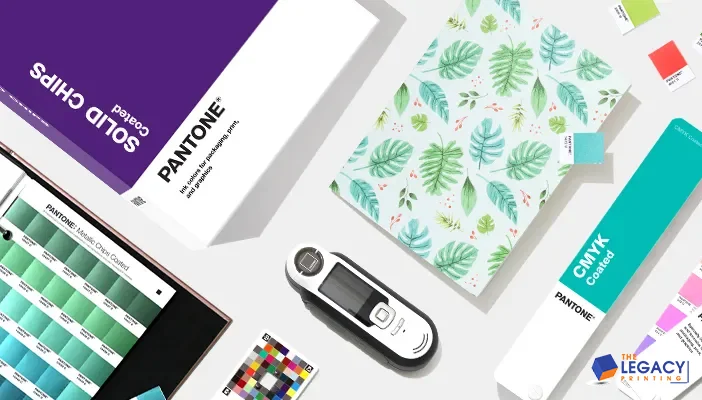PMS is a standardized color system that helps us choose the appropriate shade for our product logo or the printing purpose. Have you ever wondered how it is possible to pick the most suitable color combination with great precision and accuracy? How do the printing experts properly understand the exact color they should apply? The answer is PMS (Pantone Color System). It’s a modern way of making the color selection with the help of a unique code in the form of a number. PMS is a whole collection of colors where you’ll find approximately around 5,000 different color combinations.
We may wonder why the colors are differentiated to such an extent. This huge color variation is possible only because we can create countless variations of the same color by slight modifications in saturation, hue, and contrast. The minor adjustments in one color are identified with the help of a color code which makes it easier to pick the right one and utilize it for your brand, merchandise, or packaging.
What is Pantone?
Pantone is a US-based enterprise that defines the globally understood color language and allots a particular code to each combination. In this way, it assists different brands and retail manufacturing companies that can apply the defined color variations in the logo and make it captivating for the end-user.
The expert designers working for the firm set the industry standards, followed by graphic designers worldwide. The color system of Pantone brings more life to the product’s look and helps it stand apart from the rest of the market. Knowing that you want the printing company to apply the color you selected from the Pantone color book, they need to pick the PMS color code and start printing. The result will be a carbon copy of the idea you envisaged earlier.
Visit Thelegacyprinting Shop or request a price and tell us more about your project if you’re interested in Custom packaging!
History of PMS
It all dates back to 1936 when Pantone revived the printing industry and launched a system of color codes that set the standard in the industry. It allowed the individuals to pick a new color and slightly alter the existing one to see which looked best. The company first started as an advertising agency named M & J Levine Advertising.
The two brothers, Mervin and Jesse Levine were running it. In 1956, they employed Lawrence Herbert, who utilized his deep Chemistry knowledge to simplify and assort all the color pigments and inks in the company. Initially, he was head of the ink and color division, but later, he bought the whole company and named it Pantone.
Another great feature is that you can access the PMS color physically and digitally. To cope with the transformation in the design and application of modern practices, Pantone takes the help of tools such as Pantone Studio and PantoneLIVE. The usage of these tools helps it achieve the best results.
How Effective Is Pantone Color Matching System?
The Pantone color matching system offers a huge variety of colors that you can play with and pick the perfect fit. It can work with any equipment and make the overall printing process easier. The PMS can generate many colors and is not limited to the CMYK colors used in the printing. We can produce unique effects using it, including the metallic fluorescence touch that adds value to the color.
The designers note the color code and pass it on to the printer. The codes of the PMS system are highly specific and make it a lot easier in the right color identification. You can search Pantone’s website for any color by typing its code. The search engine on the website is advanced, and you’ll get exact results. You’ll see the color along with the listing of color books. This approach is relevant and recommended if you are already familiar with the code and looking to explore further information about the color.
How To Use the Pantone Color Chart?
Pantone has nearly 5,000 color schemes covering the whole spectrum, each with its number and name. These Pantone swatches are all designed to be used as spot colors, so they must be set up as different swatches in digital design software from CMYK or RGB swatches.
For offering assistance and helping the printers bridge the gap, a subset of Pantone colors can be replicated using CMYK printing. On the other hand, Pantone colors should be utilized as spot colors in most cases to guarantee that the Pantone Matching System functions properly. Pantone is reputable in the design and production industries because it encourages uniformity across regions, manufacturers, and equipment.
It’s not practicable to utilize visual examination alone because many items are eventually made elsewhere or with different printing equipment. The color matching system assures an exact color match at this manufacturing stage. Designers utilize Pantone color guides to define their preferred color to ensure color consistency. Once a color has been chosen, the designer tells the Pantone color number to the manufacturer or printer. This number can then be used as a reference in the printing process.
During the inspection, a Pantone color swatch and the relevant Pantone number ensure that a product’s color meets specifications. During a product examination, this is the greatest technique to check color. The graphic designers at The Legacy Printing are thorough professionals and ensure great care and accuracy in the printing process. You can discuss all the printing details with them.
What Is the Difference Between Pantone And CMYK?
Knowing the differences between Pantone and CMYK is extremely important for printing as it helps apply a suitable color combination that revives the product’s look. CMYK consists of 4 primary colors used in the printing process: Cyan, Magenta, Yellow, and Black. These are the common colors used in printers at our homes and offices. They combine to produce a huge bunch of secondary colors.
Whereas there’s no limitation in PMS regarding mixing all of these colors. You can take the help of accurate ink colors by identifying them through codes to produce the desired color. The accuracy matters as Pantone allows us to create the color envisioned at the design conception phase. However, it’s more expensive than the CMYK in cases where we need to print a small logo or emblem. Another notable difference is how they work with the on-screen color system RGB (Red, Green, Blue). We can transform RGB into a CMYK printing process, but Pantone can’t do the same.
Ways To Create Pantone Color Palette
For the convenience of users of different industries, there are separate color palettes that you can use depending on the type of material you want to print. We may find a Pantone textile palette, process palette, solid palette, or plastic palette. After selecting the right color from the collection, the printers can easily follow the command and apply the design.
Pantone now offers a unique application, Pantone Connect, allowing users to create a distinctive color palette for any project. The application also gives free access to the users so they can match the physical objects in their surroundings with the PMS color. It uses the smartphone camera to get a clear view of the color you like to match.
Product and Packaging Design PMS
Pantone uses two different color combinations, each with a unique purpose. The product design PMS is specially reserved for designing the product, and here you can apply variations in black, white, or neutral colors.
On the other hand, there’s a packaging design PMS in which we require colors that help our product’s packaging appear distinctive in the market. It helps grab the attention of potential buyers and influence their buyer intent.
As we know that the total count of all the Pantone colors is nearly 5,000. So, it won’t be easy for the designers working on the product to improvise as some colors would impact its look. That’s why the printing experts at Pantone launched separate color systems for the product and retail packaging.
Require Any Assistance Related to PMS Color?
The Pantone matching system offers more flexibility to organizations in getting their products designed with pinpoint color accuracy. The numeric codes allotted to different color combinations ease getting precise results.
The skilled experts at Legacy Printing have years of experience and are available round the clock to guide you on getting the best printing results. You can get detailed information regarding the application of PMS and CMYK and get flyers, posters, brochures, or any other object printed promptly.
It’s one of the top offset printing providers in the USA, and you can get a quote by filling out a simple form on the website. The support team will reach out quickly and share all the relevant details about custom printing.

 Cosmetic Display Boxes
Cosmetic Display Boxes
 Cream Boxes
Cream Boxes
 Eye Shadow Boxes
Eye Shadow Boxes
 Eyelash Boxes
Eyelash Boxes
 Eyeliner Boxes
Eyeliner Boxes
 Foundation Boxes
Foundation Boxes
 Hiar Extension Boxes
Hiar Extension Boxes
 Lip Balm Boxes
Lip Balm Boxes
 Lip Gloss Boxes
Lip Gloss Boxes
 Lipstick Boxes
Lipstick Boxes
 Makeup Boxes
Makeup Boxes
 Mascara Boxes
Mascara Boxes
 Nail Polish Boxes
Nail Polish Boxes
 Perfume Boxes
Perfume Boxes
 Scrub Boxes
Scrub Boxes
 Serum Boxes
Serum Boxes
 Bakery Boxes
Bakery Boxes
 Cake Boxes
Cake Boxes
 Candy Boxes
Candy Boxes
 Cereal Boxes
Cereal Boxes
 Chocolate Boxes
Chocolate Boxes
 Coffee Boxes
Coffee Boxes
 Cookie Boxes
Cookie Boxes
 Cup Cake Boxes
Cup Cake Boxes
 Donut Boxes
Donut Boxes
 Macaron Boxes
Macaron Boxes
 Muffin Boxes
Muffin Boxes
 Pastry Boxes
Pastry Boxes
 Popcorn Boxes
Popcorn Boxes
 Snack Boxes
Snack Boxes
 Tea Boxes
Tea Boxes
 Truffle Boxes
Truffle Boxes
 Wine Boxes
Wine Boxes
 Bux Board Packaging
Bux Board Packaging
 Kraft Boxes
Kraft Boxes
 Mailer Boxes
Mailer Boxes
 Bath Bomb Boxes
Bath Bomb Boxes
 Candle Boxes
Candle Boxes
 Cardboard Boxes
Cardboard Boxes
 Corrugated Boxes
Corrugated Boxes
 Die-Cut Boxes
Die-Cut Boxes
 Display Boxes
Display Boxes
 Holographic Boxes
Holographic Boxes
 Medicine Boxes
Medicine Boxes
 Pillow Boxes
Pillow Boxes
 Product Packaging
Product Packaging
 Pyramid Boxes
Pyramid Boxes
 Showcase Boxes
Showcase Boxes
 Soap Boxes
Soap Boxes
 Subscription Boxes
Subscription Boxes
 Tie Boxes
Tie Boxes
 Games Boxes
Games Boxes
 Christmas Boxes
Christmas Boxes
 Favor Boxes
Favor Boxes
 Gable Boxes
Gable Boxes
 Handle Boxes
Handle Boxes
 Ornament Boxes
Ornament Boxes
 Jewellery Boxes
Jewellery Boxes
 Telescoping Rigid Boxes
Telescoping Rigid Boxes
 Textured Boxes
Textured Boxes
 Rigid Gift Boxes
Rigid Gift Boxes


